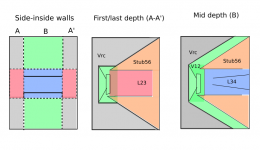What are the considerations when changing the design from from tube vents to flared shelf (I assume that's same as slot) vents?
As I've discovered with my Enigma build, when the vents get large compared to the volume being vented the effect vent length seem to be different to what predicted by simulations. So it may require a bit of trial and error to get the lengths right. Fairly easy to do this with pipe vents. Not so much with shelf vents, particularly flared ones 🙂
Here's an educated guess:
- Towards the LF port tuning frequency, the HF port section is operating well below the Helmholtz resonance.
- However, the slug of air in the HF chamber/port is still tightly coupled to the driver.
- The result there is you've got some added mass, and T/S will change accordingly: lower Fs, higher Qts. Those parameters tend to demand a lower tuning for a ~flat response.
Chris
??? 'well above' if I'm following you correctly. Good 'guess'! 😉 For a flat response it's all about balancing out the driver's front/rear acoustic loading, with the tapped pipe inherently damping the driver a bit better than port coupled cabs.
GM
GM,
>>Well, as a general rule we want an Fs a bit lower than Fb and with only a 1.5 octave BW, a low upper mass corner/high Qt driver is required.
Let me dissect this please:
If my dual chamber bandbass box as tuned at 37 and 80hz, what is Fb in this case?
Is there an optimal target for driver Fs, as a ratio to the TWO tuning frequencies?
So let's say box is tuned to 37 and 80, what's the optimal Fs of driver?
What's the advantage of a tapped horn over 6th order bandbass?
DFCBPCB: i don't understand that schematic. what does this box look like?
The lower tuning is Fb.
You seem to be confused between basic T/S vented alignments and BP alignments for compression loaded horns.
T/S theory is limited to the BW between the driver's effective lower, upper mass corner:
Flc = Fs*Qts'/2
Fhm = 2*Fs/Qts'
Qts' = 2*Fs/Flc or Fhm
Qts' = Qts + any added series resistance [Rs]: HiFi Loudspeaker Design
As you can see, Fs is the mean between the two: [Flc*Fhm]^0.5
In your case, Fs, Fb = [37*80]^0.5 = ~54.41 Hz and Qts' = 2*~52.92/35 = ~2.94, hence my suggestion to use Fs/Qts', BUT unless you have a vent large, long enough to acoustically mass load this BP back down to the driver's actual Fs, i.e. flattening/spreading out its impedance peak, then of course it will be a ~one 'note' performer and power handling will drop 'like a stone' below Fb.
What Brian said WRT both types of speaker alignment.
GM
when the vents get large compared to the volume being vented the effect vent length seem to be different to what predicted by simulations.
Right, it morphs to a stepped TL.
GM
Is there an existing proven design that will outperform the 18 sound 12" bandbass, of the same compact size and output, covering 40-100hz?
Martinsson's Blog - ROAR12
"Stub Horn 3" - puts the stub chamber at the 3rd segment - assume its a side branch (?)
Thanks! Noticed all the new abbreviations listed in the FIND Tool after posting. I got more catching up to do than available time nowadays unless I quit posting.
GM
It have been discussed here Interesting new bandpass alignment...?papasteack - what would "lol" SH3 ( DFCBPCB ( "Dual Front Chamber BandPass Closed Back") look like in its most simple cabinet build?
But i like complicate folding like bill fitzmaurice's Jack, so i would go for something like bellow for my own SH3 (just a fast and as ugly as i can sketch to answer you). I didn't finished the sizing spreadsheet, but for my 12", it seems to be something around 38cm L*38cm W*65cm H. And i still play around modding the speaker replacing actually ferrite with neo (adding copper everywhere i can, adding dual spider...) and so that qts would be tunable
 . I don't even know if i will finish it a day, it's just a hobby
. I don't even know if i will finish it a day, it's just a hobby 
Attachments
EDIT
......long enough to acoustically mass load this BP back down to the ~[0.8*Fb] tuning, i.e. flattening/spreading out its impedance peak......
GM
- Status
- Not open for further replies.
- Home
- Loudspeakers
- Subwoofers
- the secrets of 6th order bandpass
